Commentary
Posted on: September 16th, 2015 by Waterloo Region Crime Prevention Council
One of the most anticipated highlights of our year happened last week. In case you happened to miss it (?!) – although, I’m not sure how you could – Howard Sapers was in town. Yes, THE Howard Sapers. Federal Correctional Investigator for Canada and ombudsman for federally sentenced offenders.
We partnered with Kitchener Public Library as part of their new 85 Queen Speaker Series to host this event and filled the auditorium with 230 people from our community. The action packed evening included a screening of the film “State of Incarceration”, a keynote address by Howard Sapers and a panel discussion with community members, including a formerly incarcerated woman from Grand Valley Institution for Women.
-

-
Howard Sapers oversees the Office of the Correctional Investigator, serving as an ombudsman for federally sentenced offenders.
-
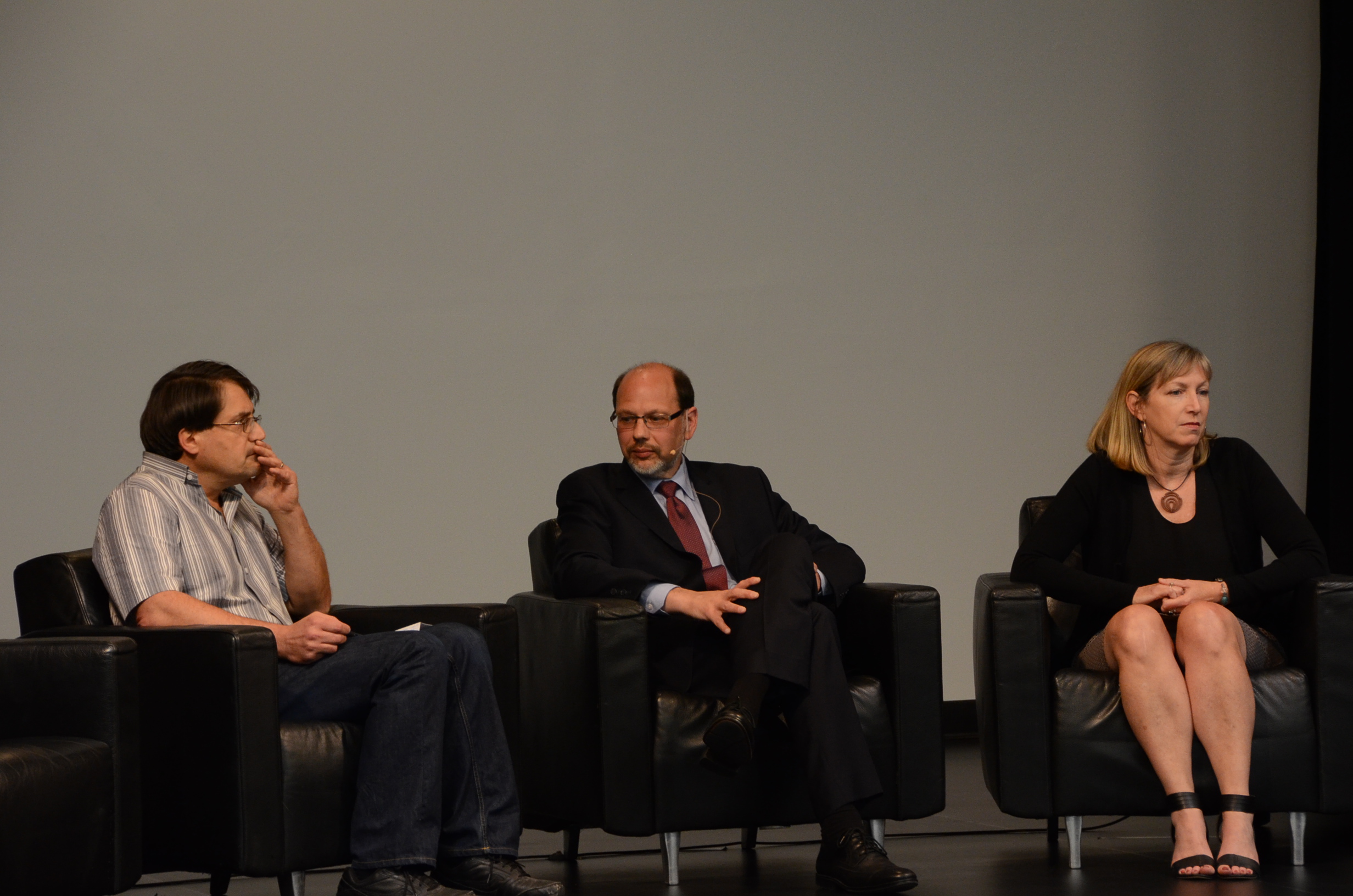
-
Panel with (from left) Chris Cowie from Community Justice Initiatives, (off camera) Joe Mancini from the Working Centre, Howard Sapers, Julie Thompson from CJI, and Dionne, (not seen, pseudonym), a former federal inmate.
-
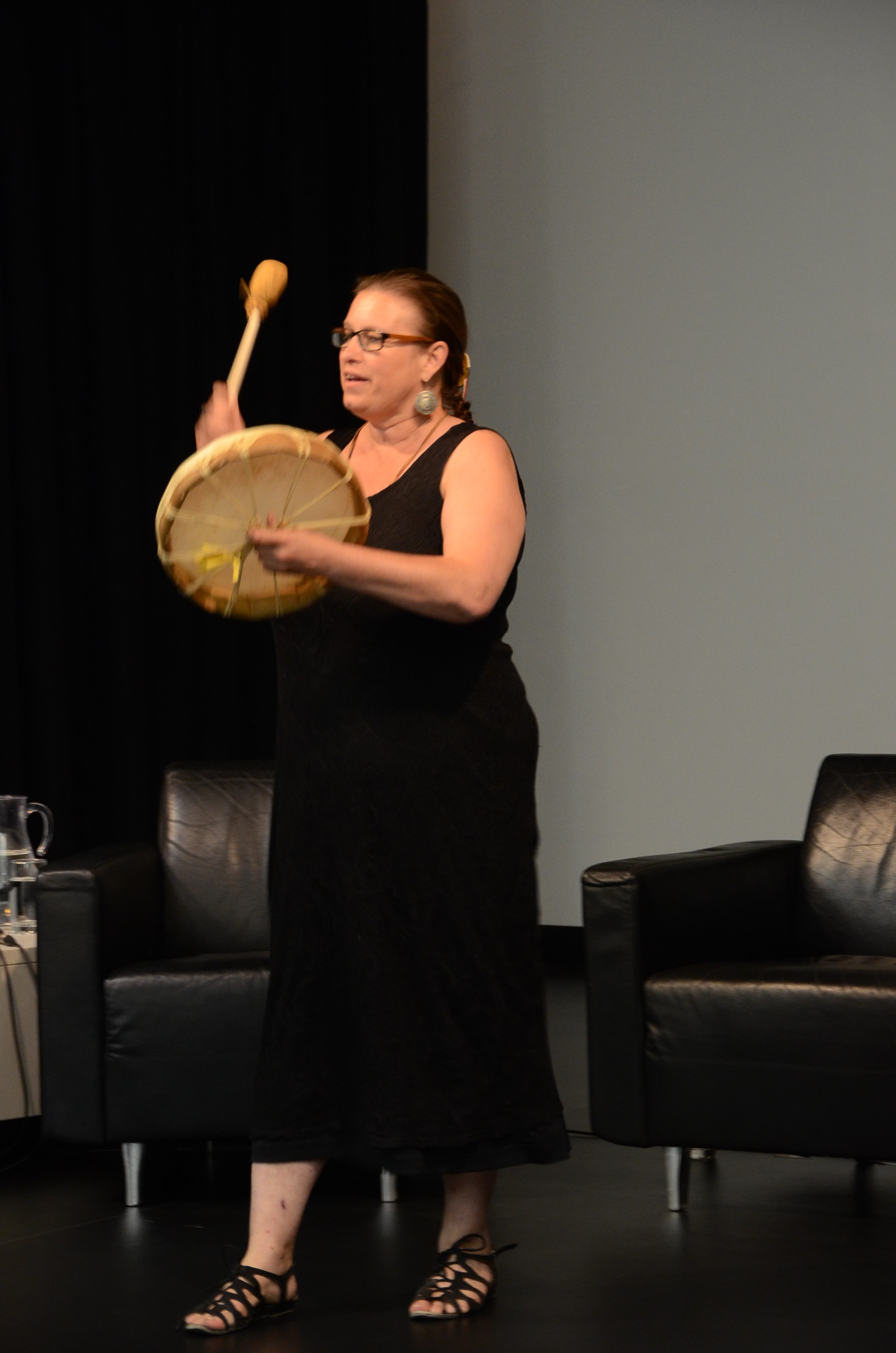
-
Aboriginal drummer Heather Majuary closed the event with drumming in honour of incarcerated Aboriginal lands.
-
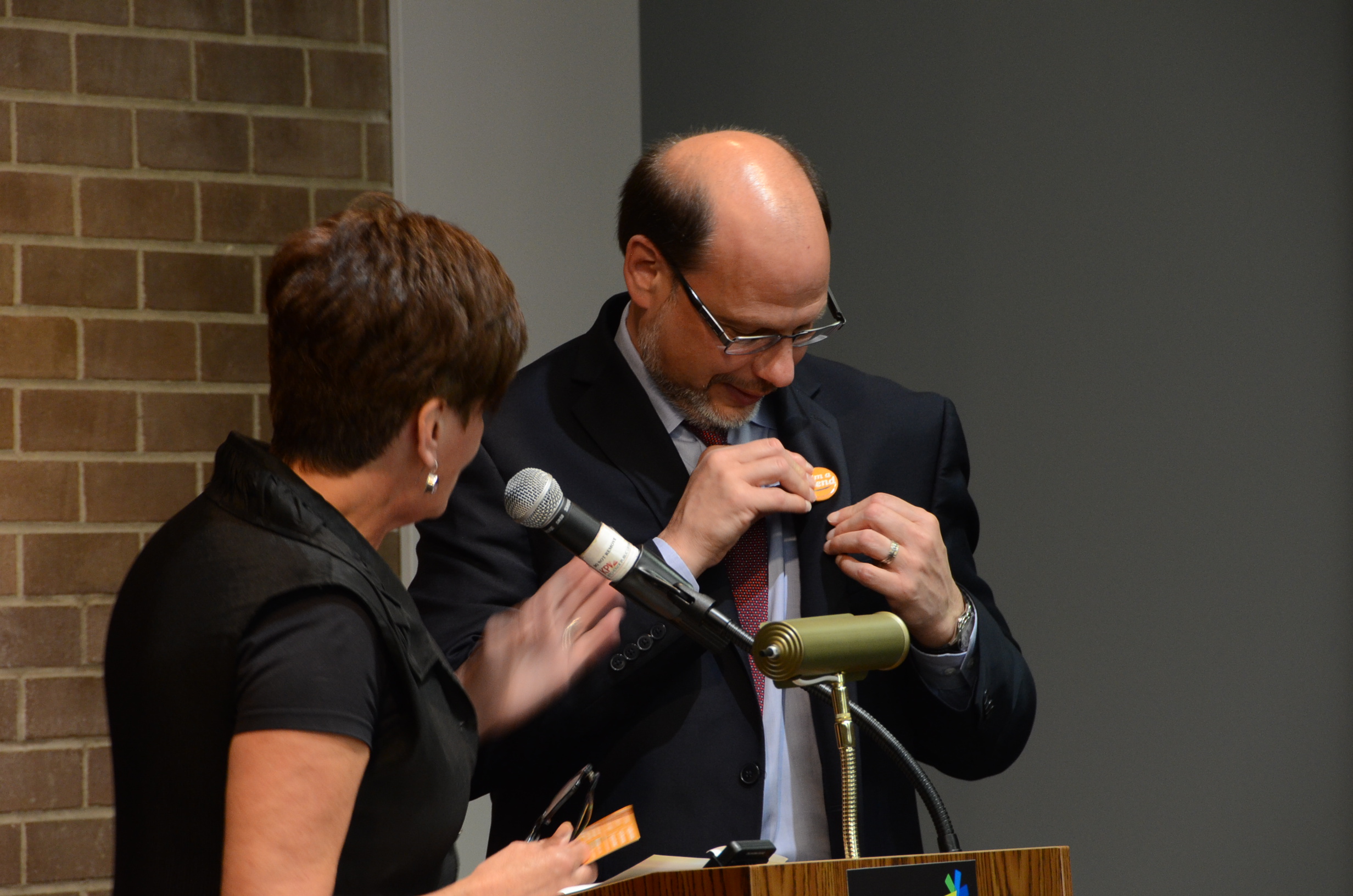
-
Howard Sapers becomes our first honourary Friend of Crime Prevention!
-
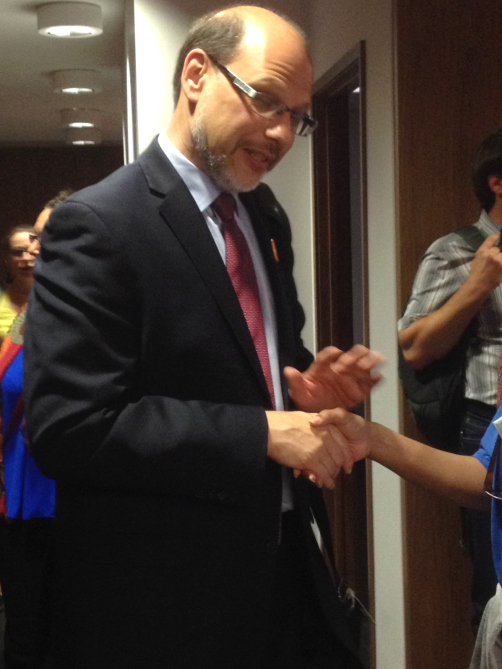
-
Howard Sapers chats with an attendee who is currently a minimum security inmate. [Source: Kitchener Public Library]
-
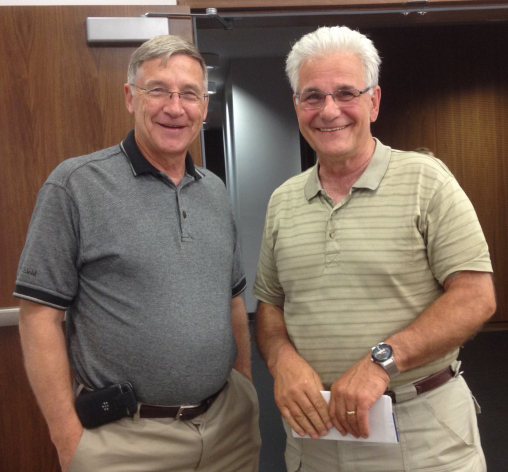
-
Regional Chair Ken Seiling with former parole officer Mark Yantzi, a pioneer in the field of restorative justice and past Executive Director of Community Justice Initiatives [Source: Kitchener Public Library]
-
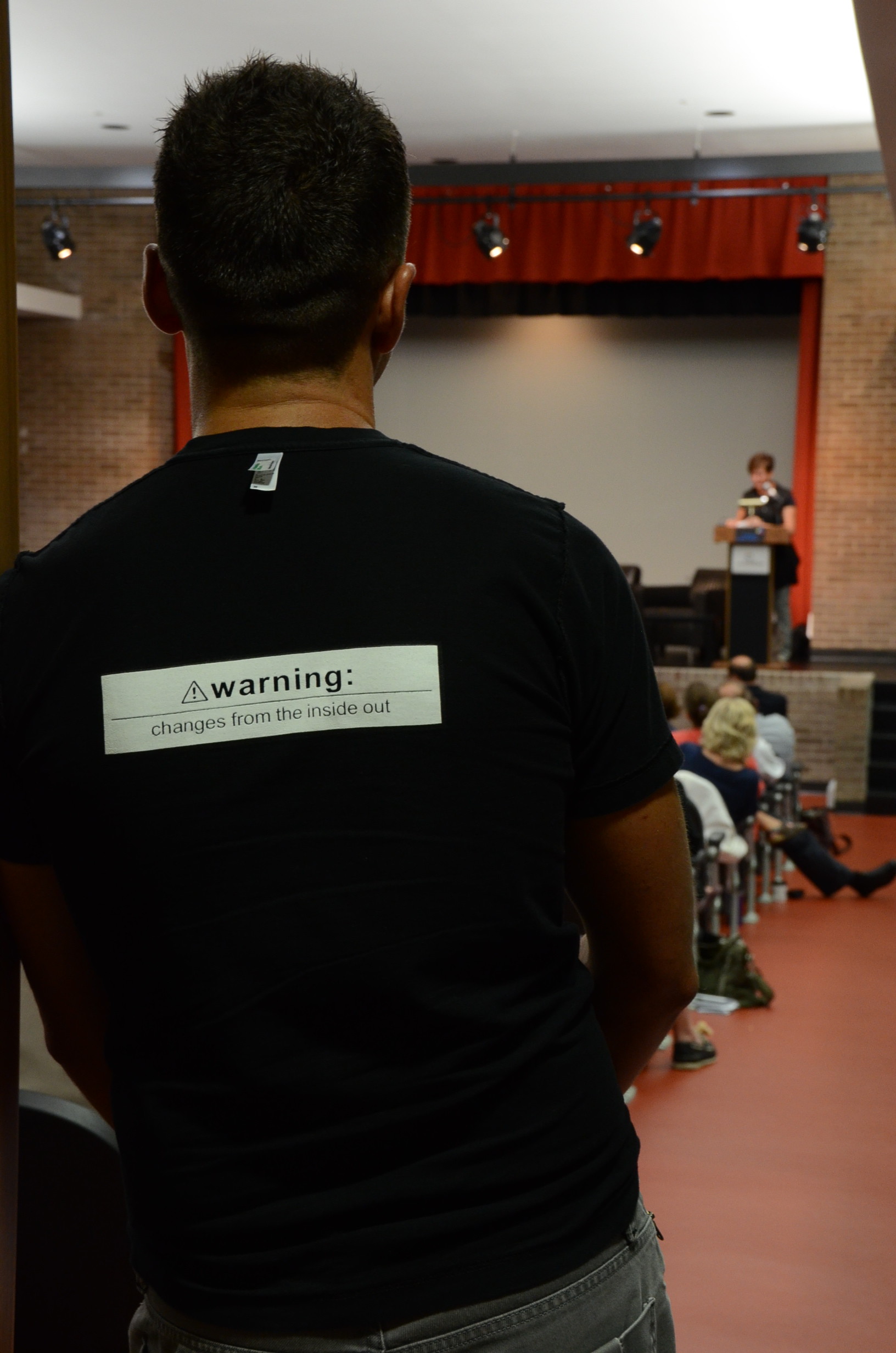
-
It’s true, change really does start from the inside. And that’s what Friends of Crime Prevention events are all about!
-
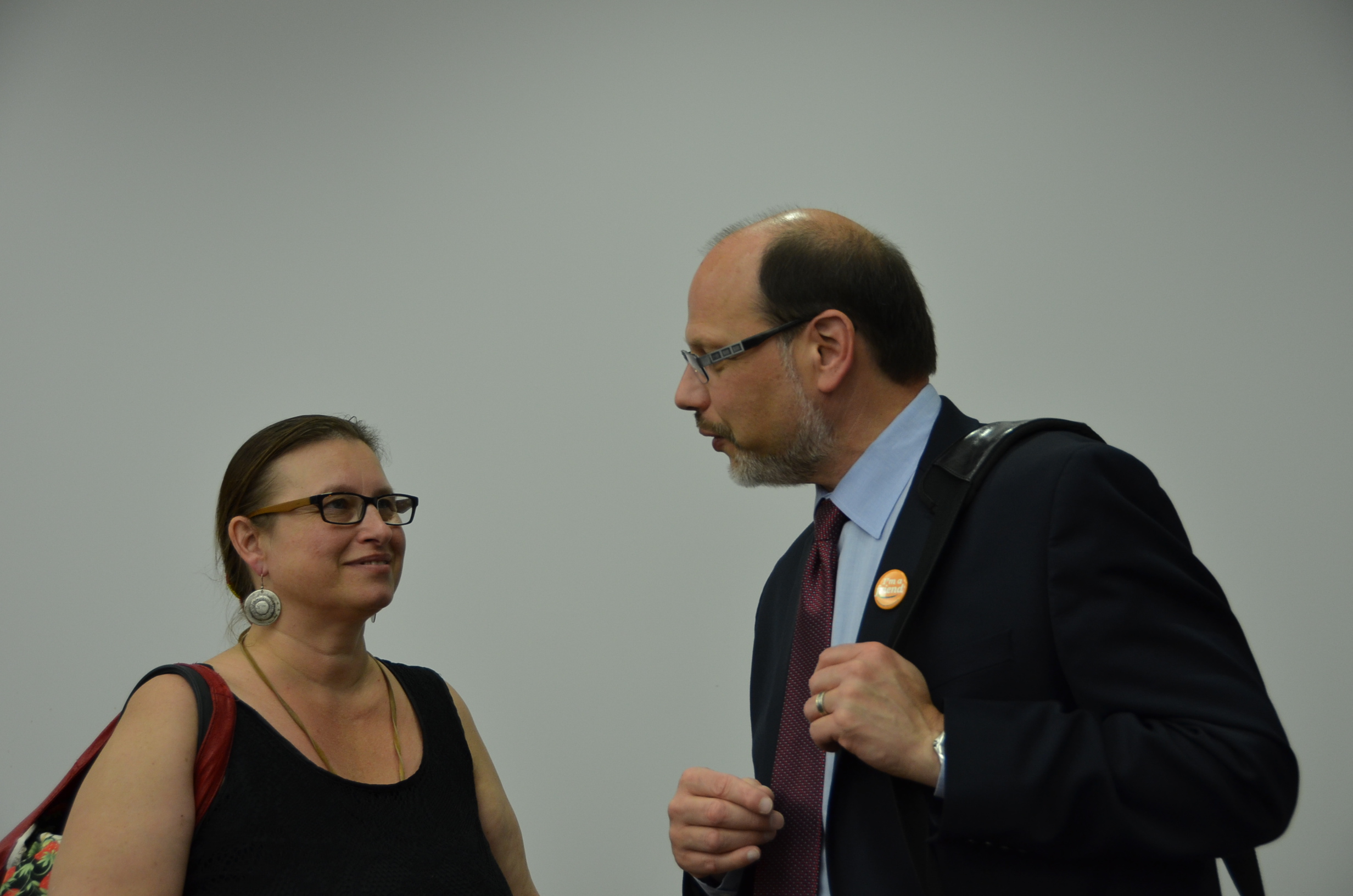
-
Howard Sapers chats with Aboriginal drummer Heather Majuary, who closed the event with drumming in honour of incarcerated Aboriginal lands
We have a video coming soon of Mr. Sapers’ keynote talk, but in the meantime, you can read his presentation here to catch all the incredible stats and stories he shared that night. He really does effectively paint a vivid picture about the state of Canadian prisons in 2015.
While you wait impatiently for the video, I”ll leave you with these two reflections from two currently incarcerated women from Grand Valley Institution for Women who attend the event. You’ll understand why it was such a big night.
Julie writes:
“I attended the forum for Friends of Crime Prevention, on September 10, 2015. I cannot begin to tell you how refreshing it is that discussions such as this are taking place. I was both shocked and pleasantly surprised at the amount of progressive people who attended the forum. There are faces and lives associated with the disturbing statistics Mr. Saper spoke of – mine is one of them. I was one of two currently incarcerated women at the event, with the Walls to Bridges Collective. Too often incarcerated people are treated as the rejects of society, disposable even, and let’s face it – advocating for us is not at the top of almost all priority lists. I firmly believe that many incarcerated people would not be in the criminal justice system to begin with, if they had been afforded access to and utilized stronger and earlier preventative measures through social intervention and more accessible social and health services; myself included. Sadly, I did not consider the flaws in our systems until I was directly affected. Now that I am, however, I cannot turn a blind eye to them anymore, not just for myself, but for the staggering amount of other people making up those statistics, and for those yet to come. I am relieved to know I am not alone in this quest. All human life has value – thank you for making “out of sight” not be “out of mind” anymore. The forum helped to humanize us and highlight some of the injustices of our daily reality. I left with a renewed sense of hope and purpose. I am thankful that this forum created a safe place for people to come together, ask questions, and push boundaries. To evoke much needed change will require more bridges to be built than walls. We have a long way to go, but I am hopeful that just as a storm starts with a single raindrop, so too does change start with forums such as this one.”
Denise writes:
Just as the world will always remember September 11, 2001, in a negative light, Thursday, September 10, 2015 will be etched in my mind for as long as I exist as an achievement to social awareness. You see, since my incarceration it was the only day in which I came in contact with people besides volunteers and members of the Walls to Bridges group and voice my dilemma while feeling safe to bare my soul. Mr. Howard Sapers provided statistics that were both daunting and hopeful. Information on how tax dollars are truly spent to build and house a growing prison population at a time where the crime rate for the past decade plus has been on the decline. I am part of those statistics and Canada is following the footsteps of the failed American system that ex President Bill Clinton and present sitting President Barak Obama stated ‘is not working’. The large majority of incarcerated people will be released and upon their discharge, are expected to function and contribute to the same society that deemed them as criminals. If education is at least a gateway to success, incarcerated people need more training to learn and utilize skills and tools required to help them successfully add to the fabric of society’s fast paced, ever changing existence. Prevention, Prisons & Popcorn at Kitchen Public Library was a forum that brought together a community of progressive thinking people aware of the challenges society will surely be faced with once the voiceless, faceless people are unconstrained. An awareness of prisons and the need for community inclusion upon the release of prisoners are part of an encompassing subject tax payers don’t realize every member of a community may be accountable for. After someone goes from inmate to civilian because they have paid their dues to a faulty justice system and they no longer live in the past where they made poor choices, when do they get a fair shot at being seen in a new light? There needs to be more discussions such as the one Prevention, Prisons & Popcorn opened up where communities are aware of their interconnectedness to their surroundings, even their walled surroundings.
Yep, it was that kind of night.
Posted on: July 14th, 2014 by Smart on Crime
This article appeared in the July 14, 2014 edition of the Waterloo Region Record.
What if you could save a life? Just one life. Would you? For almost all of us the answer to these questions is an enthusiastic yes. Without question, regardless of anything, a life, just one life, is worth saving.
But what if saving that person’s life tested your political standpoints around drug use? Would that life still be worth saving? Across this country people are dying from legal and illegal drug use. Reliable statistics on drug overdoses across Canada are difficult to find, but research by the Ontario coroner shows that on average there is an overdose every day in our nation’s capital and 33 people a year die from overdose in Ottawa. Clearly, people who use drugs along with their family and friends, come face to face with death all the time. But what can be done? How can we save people? One answer lies in the way emergency services respond when they receive drug overdose emergency calls.
If you were to witness a heart attack, you would call 9-1-1 without hesitation. You would not think of the repercussions of making that call – someone is having a heart attack and their life needs to be saved. Now try to imagine how this scenario changes: it is not a heart attack, it is a drug overdose. Our research, published in the most recent issue of the Journal of Critical Social Work , shows that people who witness overdoses think very hard about the repercussions of making that call to 9-1-1. Sometimes these repercussions are too great – people will hesitate or not call at all.
Fear of arrest weighs heavily on this life or death decision. People legitimately fear the police showing up, being criminally charged for drug possession, and for mothers, having their children taken away. All of these consequences anxiously whirl around in the panicked mind of a witness. What happens? Over half of the people surveyed do not make the critical 9-1-1 call. Some may try to help the victim themselves, which sadly can have dangerous consequences. Street remedies can often make the situation worse. The longer someone waits for medical assistance the more likely that a life will be lost.
So what can be done? How can we save people? One idea used in Vancouver is to limit police involvement in routine overdose calls. The theory goes, if you don’t send the police there is no reason to fear calling 9-1-1. Unfortunately, this solution won’t work in many parts of Canada. In many cities and most rural communities the police are often the first responder and those in the best position to save an overdose victim’s life. A more feasible, Canada-wide option is Good Samaritan Drug Overdose Laws. These laws protect overdose victims and someone who calls 9-1-1 from arrest for being under the influence, simple drug possession, and possessing drug paraphernalia. They do not protect people from serious offenses such as trafficking. Good Samaritan Drug Overdose Laws exist in several American states. Preliminary evaluation of Good Samaritan Drug Overdose Laws out of the United States show that 88% of opiate users are aware of the law and are more likely to call 9-1-1.
Making naloxone, also known as Narcan, available in every province without a prescription is also an essential piece of this puzzle. Naloxone can be easily administered and it temporarily counteracts the effects of drug overdose, providing precious time to get the person to the hospital. The Ontario Health Ministry recently introduced naloxone for public distribution and emergency responders watch in amazement as the compound saves lives.
Ultimately if we truly believe that every life is precious, then the answer is policy change. We need to reduce the barriers to calling 9-1-1 during routine drug overdoses by providing limited legal immunity through Good Samaritan Drug Overdoes Laws and we need to work on distributing naloxone across Canada, barrier-free. That life, that one life, would be saved.
If you ever are unfortunate enough to witness a drug overdose the correct course of action is to call 9-1-1, perform CPR if the victim has stopped breathing and administer naloxone if you have access to it.
Author: Kayla Follett is a Master of Social Work graduate, with the Newfoundland and Labrador Sexual Assault Crisis Centre. Her research on this topic was conducted during an internship with the Waterloo Region Crime Prevention Council, and was published in the July 2014 issue of the Journal of Critical Social Work (co-authored by Anthony Piscitelli, Michael Parkinson and Felix Munger).
Posted on: April 10th, 2014 by Smart on Crime
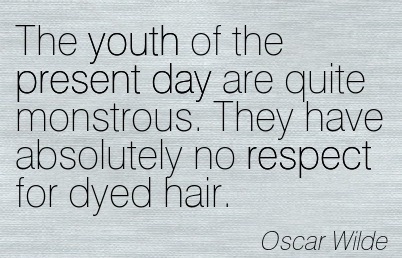
My path in crime prevention started almost 20 years ago; my formal path that is. But, even prior to that, my work with those who were marginalized and/or victimized was also “crime prevention”. I just didn’t know it then. I certainly didn’t call it that. I know better now!
Justice goes well beyond the walls of courthouses and prisons to the heart of citizen capacity and imagination. In a way, justice lives in a tension between security and democracy. Security, of course, frequently uses methods to exclude certain people from certain places. Democracy, on the other hand, can be measured by the extent of our willingness and ability to include all people. Places where everybody matters, even those, or maybe especially those, who make us somewhat uncomfortable, are something to aspire to in democracy. But measures of security will often tell us the opposite. Herein lies the rub. And it is often no more obvious than in our interventions with youth.
Throughout time youth have caused us some discomfort. Not because of whom they are, but because of the associations that have been created between youth and crime. How we treat those who are in that critical transition between childhood and adulthood is an essential measure of the character of our community. How we interact with youth, how we express ourselves to and about them, says so much about us. It may not actually have a whole lot to say about them.
“We must learn to work for young people but also with young people. Our society must learn to trust them and avoid generalizations which stigmatise them, or portray them as potential criminals. The challenge to us all is to guarantee the legitimate right to safety of each and every person without discrimination and the scapegoating of youth.” (European Forum on Urban Safety, 2000).
It is good news then that progress often seeds itself in grounds of dissonance. Discomfort can be an opportunity for growth and learning if we only allow it to be.
inREACH was a golden opportunity. It brought discomfort in so many ways that we can only be grateful. We got to test assumptions about youth generally and street gang prevention specifically. We ended up rocking our boat of easy answers.
I am no expert in crime prevention. I have searched high and low for such person and have yet to find one. I am certainly not it. There are no bumper stickers in crime prevention no matter who brings them to you (and sometimes those who bring them have formidable power). The issues of crime, youth crime and street gang related crimes are immensely complex. They defy convenient truth. Sure, it is true that there is solid evidence to suggest that some children and youth are a greater risk of coming in conflict with the law. There is also solid evidence to suggest that this can be prevented. It would therefore make a whole lot of sense that we invest more in preventing children and youth from becoming involved in crime than we do in warehousing them through their teenage and adult years. But such sustained commitment to community safety can only thrive in an environment that distinguishes facts from fiction. And few things seem to be as fraught with myth and fiction as youth crime.
And that was the whole point. inREACH was about learning what works not what we believe to work. And whenever we are on a learning path we will encounter screaming successes as much as fabulous failures. At inREACH we had to not only dispel the overused myth that connects youth and crime, we also had to dispel the myth of singular professional expertise, as well as the myth of being a community where inclusion and collaboration are always easy. We finally had to learn that outcome measures are an empty promise at the beginning of such journey.
What a gift!
And without the voices of youth and true efforts at inclusion that gift would not have been possible.
But “kids at risk” are not supposed to be engaged in shaping public policy; they are supposed to live at the fringes of the community – not on its stages. But we found that listening is a most powerful method for changing trajectories. Listening can begin to untangle the complex interplay of individual traits, family, community, and wider social supports. And when we listen we learn so much.
- We learned that risk factors do not follow a neat mathematical “1+1 = 2” formula. As much as one more risk can bring a person to the precipice of crime, so one resilience factor can stop him or her from falling off. This resiliency can be sparked by a significant adult who refuses to give up, a teacher with an eye not only to the irritating behavior but the roots of it, a school that deals with the social inclusion first and academics next, programs which assist stressed families by first and foremost meeting their essential needs of life.
- We also learned that we can ALL be essential partners in this quest for safer communities and civic vitality if we make the connection between basic needs (such as food and shelter) and meaningful engagement, sense of belonging and viewing others as opportunities not threats.
- We also learned that knee-jerk reactions, approaches rooted in fear, or a philosophy of blame are the greatest barrier to successful prevention.
In the never ending circle of seeking who is to blame we have become confused and numb to our own opportunities to be part of scripting a whole new story about us and the young people among us – ALL young people. In a way, inREACH was an opportunity to test our resolve to focus on prevention sometimes despite of it all. It was our opportunity to wiggle in discomfort as we sought out momentums for sustainable change.
The moral of the inREACH story is that no one system alone is equipped to deal with the complexity of gang related crime. We had to work in partnership. It was not a choice. Hats off to Dr. Spergel for saying all that so many years ago, long before we ever even conceived of inREACH. But “partnership” is not an old boys/girls club or tired relationship on auto pilot. Partnership is a vital agreements to work together, to share a vision, to establish a set of values, to be held collectively accountable, to disagree, and disagree some more, but to never stop moving forward together. Partnership does not end at the board room doors but rather moves us into the heart of the service we provide. That was the task we set for ourselves and it was a difficult task indeed.
The confession that easy answers are little else than a distraction from the larger social and community roots goes hand in hand with the invitations to citizens to overcome such psychology of learned helplessness. Learned helplessness is the outcome of a gradual but persistent chipping away at our collective confidence that anything can be changed let alone that we can be part of that change agenda.
Ask most people what to do about crime and at first they reach for the 911 dial. Give them the opportunity to recognize the power of everyday action and they can rally together in a way that goes beyond our wildest imaginings. The neighbourhood mobilization work of inREACH exemplified that more than anything I have ever seen. From parents to teachers to artists; when we merged the stories of those in social services with the stories of everyday citizens and those with lived experience, a comprehensive plot emerged in which truly everybody mattered.
Too often have we developed services first and the asked why. In this “we know what is best for you” mentality we often even maintain programs out of tradition, not because they worked. Such skewed problem solving is, at least in part, the outcome of organizational distance to the people we serve. inREACH youth came up very close and personal. And we were and are richer for it.
Some answers of convenience are not wrong in and off themselves. They are just wrong by way of their omissions. inREACH youth had a voice and in hearing that voice we designed an approach that was rooted in their reality even if it wasn’t always popular or comfortable. In helping them to break their silence we had to face our own fear of contempt, censure, judgement or lack of recognition. But in the words of Audre Lorde: “The fact that we are here is an attempt to break the silence and bridge some of the difference between us, for it is not differences which immobilize us but silence”.
I so look forward to tomorrow. Tomorrow is our chance, free of the confines of funding (yes there is freedom in not being funded) to again amplify the voices of those who live and lived it, and those who had the courage and wisdom to live it with them.
In the end, it is up to all of us to say: OK! We hear you! Now what?
Author: Christiane Sadeler is the Executive Director of the Waterloo Region Crime Prevention Council.
Posted on: January 6th, 2014 by Waterloo Region Crime Prevention Council
“I feel responsible…..” These are the exact words from a parent following a neighbourhood discussion about youth, drugs and addiction. But it’s maybe not the story you are imagining.
In my work as Community Engagement Coordinator with the Waterloo Region Crime Prevention Council, I spend some of my time with neighbourhoods, working through issues and challenges that have emerged over time or might be the result of a community crisis.
After facilitating a few meetings during the summer and early fall with a group of neighbourhood parents, they decided they wanted to learn about issues of substance use, addictions and youth. As parents they were very clear that they wouldn’t want their own children to use drugs, but they needed a better understanding of why some youth would take or use drugs, including youth in their own neighbourhood.
One evening, we watched the film Reduce Speed – a documentary about 5 teens who share their experience with using crystal meth. The film is told with their voices, their stories, their reality – which is helpful for adults to hear!
The film is heavy and is difficult for any parent to watch. “Sad”, “concerned”, “worried”, “depressed”, “at a loss”, “sick”, “sorry”, “serious”,…. were words these parents used to describe how they felt after seeing this 22 minute film.
A 2 hour discussion followed and we covered a lot of territory:
- how parents talk to youth about drugs and alcohol in a way that doesn’t become confrontational
- the challenges and pressures youth face about drugs and alcohol on a daily basis
- what might prompt youth to use drugs
- what youth see in their own neighbourhood with respect to drugs and alcohol use
- what might be some root issues or causes for youth who use drugs and alcohol
- what can the community do and who can help
The group plans to gather again to deepen their learning and understanding and move toward some action.
Before leaving the group, I asked each person to use one word to describe how they felt at the end of the evening. “Encouraged”, “hopeful”, “inspired”, “happy”, “energized”, “grateful”…. very different feelings than at the beginning of the discussion!
But something profound happened when one woman interrupted our leave-taking to add one more thought; raising her voice to be heard above the scrapping of chairs and rustling of coats, she said clearly, “I feel responsible”. She went on to explain that, before, the problem felt too big, too insurmountable, but she gained a different perspective through the film and our discussion and wants to be part of creating a change in her neighbourhood through her own actions, together with her neighbourhood.
This was a stunning moment, one that brought a lump to my throat. To see the roots of change emerge before my very eyes is a rare thing. This woman knows that everyone has a role to play in prevention, no matter how small or big, and that through individual and collaborative leadership, we can make change happen.
I can’t wait to see the leadership, action and responsibility that this group will take in 2014.
What kind of change will you be part of in your neighbourhood this year?
Posted on: April 24th, 2013 by Waterloo Region Crime Prevention Council
This is the official position statement of the Waterloo Region Crime Prevention Council given at a public consultation on the question of a casino in the City of Kitchener. The remarks below were given by WRCPC Executive Director, Christiane Sadeler on behalf of the Waterloo Region Crime Prevention Council.
Thank you for the opportunity to speak with you tonight on the topic of a casino in Kitchener or the Waterloo Region. I am representing the Waterloo Region Crime Prevention Council; I also live in downtown Kitchener.
The Crime Prevention Council opposes the opening of a casino within Waterloo Region. However, in the event that a casino should be opened here, we recommend that the development and operations of the casino must incorporate crime prevention considerations and harm reduction strategies from the very beginning.
We have provided you with a full copy of the position statement and also included some materials that we believe are relevant in this context. The position statement is also available on our website (www.preventingcrime.ca). In the interest of time I can only highlight a few aspects of the position.
There has been no dialogue that did NOT at some point mention the concern that crimes increase in the proximity of casinos. Your own city online survey mentions safety along with considerations of health, city image and so on. Fear of long term impact on our quality of life is often as detrimental as crime itself. Perceptions can become reality. Right or wrong the connection between casinos and crime is part of public discourse. And perceptions are hard to change. We know that by now.
But what does the evidence tell us?
This is where it gets a little more grey. The research findings about a connection between crime and casinos are mixed, if not inconclusive. It would not be correct to claim that casinos have a DIRECT impact on crime, at least not an impact that would differ from that of other large entertainment facilities, at first sight. Direct links between crime and any one community action are hard to come by and must always be seen in the context of decreasing crime rates in the last decade.
We therefore must look beyond the direct connections to what we know about risks. What puts us at risk of crime, victimization, and fear of crime? It is here that the public health research is compelling and worthy of your in-depth consideration. We know that over 30% of profits in gambling come from problem gamblers and those at risk for gambling addictions. We know that these individuals share characteristics that are best defined as root causes of crime. We have detailed them in our position statement along with a report about root causes. We encourage you to consult both.
Simply put, whenever we increase the vulnerability of those already at risk, the financial and human burden to them and their families are quickly matched by the community and social costs. While casinos may not directly lead to increases in street level crime, they do lead to increases in other social ills and crimes, such as, intimate partner violence, addictions, etc. From a prevention standpoint these should concern us as much as public safety and disorder issues.
Problem gambling erodes the health of individuals and those close to them and by extension, of the communities in which they live.
The Ontario Lottery Gaming Commission does not deny that gambling addictions exist and that they come at a cost. These are brochures that are provided right at the Windsor Casino entrance, alerting patrons to these risks.
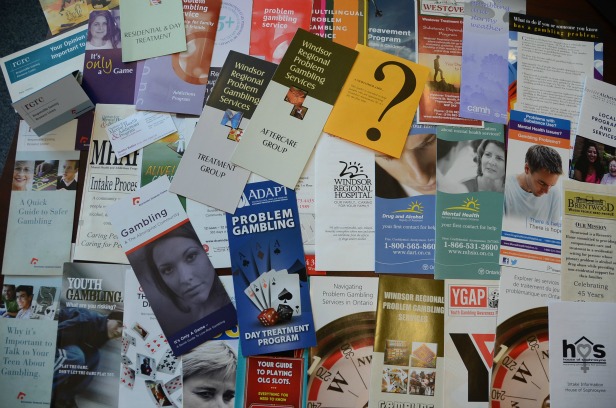
© 2013 Waterloo Region Criime Prevention Council – Over 40 brochures available at the entrance of the Casino in Windsor, Ontario. Problem gambling treatment services to bereavement, mental health and addictions to information targeted to youth, seniors and newcomers. One brochure is provided in multiple languages.

© 2013 Waterloo Region Criime Prevention Council
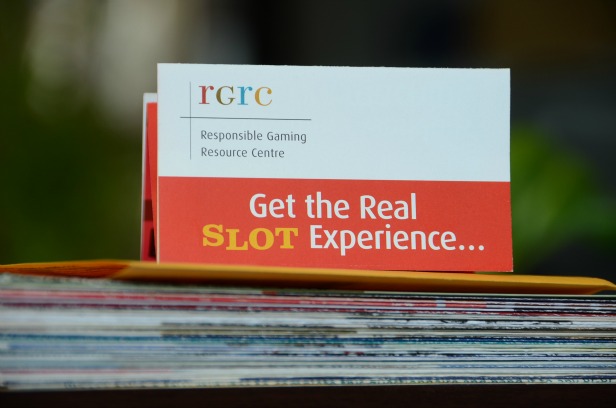
© 2013 Waterloo Region Criime Prevention Council – A 11/4” stack of brochures offering problem gambling treatment services to bereavement, mental health and addictions to information targeted to youth, seniors and newcomers.
So, gambling facilities come with warning label. They also come with treatment recommendations if the warning labels were not effective. This is not forward thinking. This is resigning ourselves to the fact that along with these facilities will come problems.
Prevention is cross-generational. Are we OK with a baby born in 2013 becoming the casino patron of 2033? If the answer is, even remotely, “we are not sure”, then we need to hit pause and look more deeply at the research and the rationale for considering a casino here in the first place. Will the benefits justify the costs? Are we informed by the “8-80” concept? Is it a good decision for the 8 year old in our community AND for the 80 year old in our community no matter what walks of life they come from?
Most people who gamble may not engage in criminal activities. But those at risk of gambling addictions are vulnerable to many other issues that come at a social cost, crime among them.
We believe that for the crimes committed by the offender he or she is responsible; for not dealing with the root causes of crime when these are known to us, all of us are responsible.
However, if the decision is to bring a casino to our city the Crime Prevention Council recommends that prevention and harm reduction methods are included in the development and operations from the very beginning. In the position paper, we have outlined 12 harm reduction recommendations. These include considerations about alcohol consumption, placement of ATM machines, opening hours, self exclusion programs etc. The first recommendation is to establish a region wide advisory group with expertise in problem gambling prevention to provide input from the beginning, including during the RFP process.
In conclusion, the decision that you are faced with, in the mind of the Crime Prevention Council, is not to be taken lightly. It is a decision that will affect the well being of generations beyond all of us present here tonight. Waterloo Region is one of the safest and ultimately prosperous communities in Canada. We have become known for innovation and forward thinking. There is little innovative about a casino. We are on a solid path of creating and maintaining a safe and healthy community. It is hard to imagine that we can lose by passing on the idea of a casino. It is easier to imagine what we might lose if we take this on.
Thank you for your time and we wish you well in your decision making.
Christiane Sadeler is the Executive Director of the Waterloo Region Crime Prevention Council.
Posted on: January 18th, 2013 by Waterloo Region Crime Prevention Council
At a recent event to launch the Friends of Crime Prevention network, we were so fortunate to have Alan Quarry, of Quarry Communications, as our guest. Since we’re all about positive social change, we asked Alan to wax poetic on the power of networks, like Friends of Crime Prevention, to advance social change. Anyone looking for tips on the latest tools, apps and gadgets to use might have been disappointed by Alan’s talk… because really, it’s all about relationships, not the technology, which we already knew. Right?
Creating change that lasts happens in relationships, from one person to another, and these days, often facilitated with the power of social media. Here are Alan’s 7 best thoughts on the principles for engaging people in change.
- “We build too many walls and not enough bridges”. Isaac Newton
Plain and simple…. Walls separate people; Bridges bring people together. Networks can only be successful if they are built on the principles of a good bridge:
– bridges are intended to facilitate two-way interaction and communication, comings-and-goings and flow of pedestrians and traffic; they connect physical spaces to each other across seemingly uncrossable barriers like water, chasms and gorges
– bridges are (typically) not controlled by one side or the other
– bridges do not have trolls! or at least, they shouldn’t!
– bridges are intended to be multipurpose and can accomplish a great diversity all at once
– bridges need care and maintenance in order to last for a long time
– bridges inspire people and we are naturally drawn to them to admire; while many bridges are utilitarian in nature, many more are grand and quite beautiful to look at
– bridges can often connect very different worlds and be an entrance into exploring a very new and different place
– bridges can act as ‘neutral territory’, which can be a very good thing at time!
Having said all that…. bridges can be uncomfortable places for people with a fear of high places. It can take work for some people to engage in these spaces – be patient with them! But if there is a compelling reason for them to be there… they will.
- Networking is not about hunting. It is about farming. It’s about cultivating relationships.
Networking is a key component of building any network, not just Friends of Crime Prevention. But how to engage people who are interested in sticking with the network for the long haul? It’s about building genuine relationships with everyday people. It’s not about head-hunting big names or seemingly important people. Some relationships take longer to develop than others, but guaranteed, an investment in a solid relationship with someone will build stronger connections and commitment to your network.
- Build it, and they won’t come
 Enough said. You can build a bridge, or a network…. but that doesn’t mean everyone will want to take part or use it… especially if it’s poorly designed and built! It’s important to put careful thought, planning and resources into whatever you design. And opportunities to improve it are always there!!
Enough said. You can build a bridge, or a network…. but that doesn’t mean everyone will want to take part or use it… especially if it’s poorly designed and built! It’s important to put careful thought, planning and resources into whatever you design. And opportunities to improve it are always there!!
- Focus on how to ‘be’ social not how to ‘do’ social
Many attempt to engage people can ring false when there is a lack of authenticity in the engagement. You can ‘do’ all the right things when it comes to social and community engagement but if your online & in-real-life personality don’t match – people can become quickly disengaged. Sharing good content – relevant, personal and recent – with the right people, at the right time, shows you understand the important of connecting in the right way.
- You have to make an effort to connect with people. It’s not called ‘net’sitting. Work at it.
Yes. And yes. It’s not enough to have online profiles everywhere and attend every community event possible if you don’t actually engage with people. Just because there’s a Facebook page and a Twitter account doesn’t mean people will flock to you in droves. Work at making connections that make sense. Avoid the flailing arm approach to engagement.
- Social media is high touch, not high tech

Like the construction of this bridge, there is some technical thought that goes in to building a network like the Friends of Crime Prevention, and effectively using social media to help it grow. The real success of the bridge in the photo is whether or not people come to gather there when the vendors fill the shops on the sides of the bridge – the high touch part of the equation. We can’t expect technology alone to sustain relationships. We’ve got to do that part in person.
- “Be positive – care, share and be friendly”
According to Alan, this statement is also the Quarry Family motto. But it sure applies to something like advancing the ‘Friends of Crime Prevention’ network. Really, who flocks to be part of something negative, territorial, selfish and unfriendly? I just don’t think it would work for something called ‘Friends of Crime Prevention’!
Truly, Alan’s presentation for the Friends of Crime Prevention event got people talking and primed to help grow the network. People talked about actions they could take as individuals and organizations to help advance the work of crime prevention through social development in their own workplaces, homes, schools, families and neighbourhoods. Ideas are percolating. Discussions are happening. Links are circulating. Tweets are tweeting. Phones are ringing. In all, I’d say, a pretty good ROI for the day.
Return on Interaction, that is.
Thanks Alan Quarry!
What were the stand out ideas you learned from Alan at this event? Is Friends of Crime Prevention on the right track? Love to hear your thoughts – leave a comment!
Posted on: July 16th, 2012 by Smart on Crime
You may have been taken in by one of those urban myth emails that float around our inboxes from time to time. You might have seen the one we’re about to bust for you.

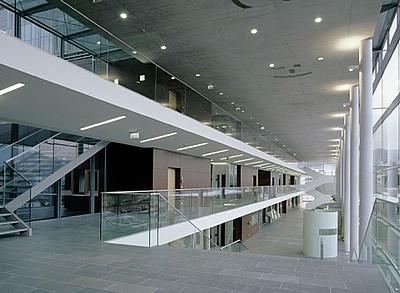

The email we’re talking about arrives with a subject heading along the lines of “Can you guess what this is? You won’t believe it!!” The email contains photos of a state of the art looking facility complete with recreation spaces and lounges.


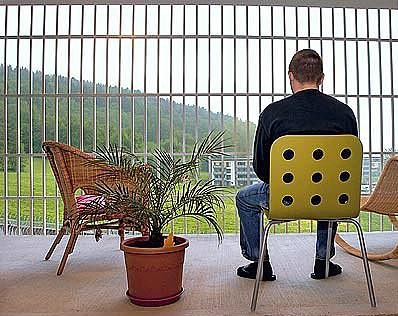
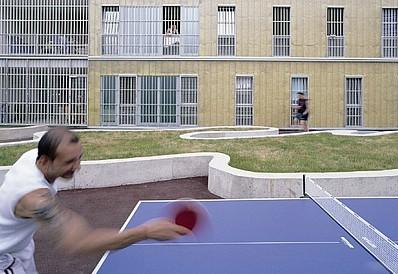

It looks clean, comfortable and well designed. It could be a seniors facility, or maybe a community or health centre.
The photos are beautiful and believable and it looks like a pleasant place to be.
It’s the next sentence that sparks a sense of outrage and indignation! “THESE ARE PHOTOS OF A NEW PRISON FACILITY, JUST OUTSIDE OF TORONTO!!!!!!!!!!!!!” The email we received did actually include the ALL CAPS and bold for emphasis!
This is entirely false. Almost.
The first part is true. These are indeed photos of a prison facility, but not in Toronto. These photos are of the Justice Center Leoben, a minimum security prison in Austria. A combined court and prison complex dedicated to rehabilitation, Leoben is for inmates from all walks of life but they are carefully selected for their motivation to change. It runs more like a shared accommodation facility in an attempt to prepare people for the real world when they are released. Prisons are commonly not a great training ground for the world beyond their walls. It may be because we forget that, except in very rare situations, people do get out and live back in their communities. The more prepared they are to make this transition, the better their chances of not returning. As Graham Stewart (former Ed of John Howard Society Canada) once said: “You can’t teach people how to play tennis in a submarine.” Likewise, it’s hard for people to change attitudes and behaviour in an environment that doesn’t remotely resemble real life.
Prison is the withdrawal of liberties and freedoms. It is not meant to be punishing but rehabilitative. The motto of the Justice Center Leoben is “All persons deprived of their liberty shall be treated with humanity and with respect for the inherent dignity of the human person.” While this prison is only marginally more expensive than other facilities, their recidivism rate is minimal to none. The model has also been replicated in Norway’s Halden Prison with similar success.
Someone out there started floating these photos as an attempt to say that in Canada and the US (it was also said to be a jail in Chicago…. which isn’t true) prisoners receive better treatment than seniors and those in need of hospital care.
Let the myth be busted.
The story has been misrepresented and the photos are not from here. But even if they were, the idea that people are keen to go to jail for the nice facilities is as real as the idea that people are keen to go to an oncology ward because they have shiny new equipment there. It just doesn’t make sense.
Here’s hoping you think carefully about the next mythical email that wings its way into your inbox.
Posted on: January 19th, 2012 by Smart on Crime
Thank you to everyone for reading, sharing and commenting on our previous 5 posts outlining the position of the Waterloo Region Crime Prevention Council with respect to the Omnibus Crime Bill (C-10), the Safe Streets and Communities Act. One of the most common questions we received was, “So… what happens now? Has the Bill fully passed? How soon could this all start happening?”
People lamented not paying more attention in high school Civics class!
Here’s what we know.
The Safe Streets and Communities Act was passed in the House of Commons on December 5, 2011. Bill C-10 passed first and second reading in the Senate by December 16, 2011. It was then referred to the Standing Senate Committee on Legal and Constitutional Affairs, where it rests until Members return to the Senate on January 31, 2012. It is expected to remain with this Senate committee for several weeks in early February and then return to the Senate for a third and final vote expected around mid-February. It is expected to pass. After that, it becomes legal reality.
We’ve also been following some of the speeches and discussion regarding Bill C-10, every word of which can be found online via the parliamentary website.
If you want to read what has been said by individual Members of Parliament about Bill C-10 in the House of Commons, the open data website, openparliament.ca, provides a quick source, along with a full record of the votes. We also took a look at the presentations made by witnesses (delegations) before the Standing Committee on Justice and Human Rights to gauge the level of support or opposition for Bill C-10.
Every justice based, crime prevention-oriented organization and community across Canada, whether in support or opposition to Bill C-10, will be waiting to see how the next steps play out. Bill C-10 could change the face of the Canadian justice system as we know it and we will all be affected, directly or indirectly, in some way.
So, now we wait….
Special thanks to Olivia Boyington (University of Waterloo) and Kayla Follet (Wilfrid Laurier University, Lyle S. Hallman School of Social Work) for preparing the summary of presentation to the Standing Committee on Justice and Human Rights.
Posted on: January 12th, 2012 by Smart on Crime
Of course! Who wouldn’t support a greater voice for victims? Who wouldn’t agree that internet sexual exploitation of children must be stopped? Who wouldn’t want to send the message that one crime is one crime too many?
WRCPC wishes for and works for safer streets and communities and we do so alongside many other municipalities. But we are deeply troubled by the wholesale nature of the proposed legislation whereby Canadians need to accept the bad with the good. The government has a mandate to invest in the prevention of crime and to bring justice. C-10 as an omnibus bill simply cannot accomplish that.
We therefore ask that the Senate of Canada do due diligence and engage in sober second thought and review C-‐10 bill by bill, step by step as the only reasonable review to deal with the complexity of the legislation at hand. We also ask that prevention be taken seriously during this review. Prevention has worked, continues to work and stands a better chance of delivering safe streets and communities than C-10 in its current form can.
We went to hear from you. What do you think about the potential for Bill C-10, the Safe Streets and Communities Act?
This is the last section of the position paper from the Waterloo Region Crime Prevention Council. Earlier sections of the position paper are available here on the Smart on Crime blog:
Posted on: January 11th, 2012 by Smart on Crime
It costs anywhere from $70,000 to over $130,000 annually to house one person in a correctional facility. Many of these inmates have a history of low educational and employment achievements, learning disabilities, Fetal Alcohol Spectrum Disorder issues, significant mental health and addiction challenges or other mitigating factors that may have contributed to their actions. These conditions do not excuse their actions but it helps us to understand them with a view to prevention. While in the past these considerations were part of the application of the law for the purpose of rehabilitation (a key correctional mandate), providing only for aggravating circumstances in mandatory minimum sentences decontextualizes crime. This approach will without doubt create a sizeable group of prisoners with little to no chance of succeeding in society upon their release. Mandatory minimum sentences make the offender, his or her context, personality, upbringing, intellect, morality or addiction irrelevant. They fail to take into account ongoing treatment needs for addictions or mental health issues or developmental delays. Minimum sentences also adversely affect the family the perpetrator leaves behind, particularly if there are children in continued need of support. This increases the risks for children whose parents are incarcerated, extends the cycle of victimization and extends the root conditions that lead to crime to the next generation. Simply stated, the human and financial costs of pro-social measures will always be substantially lower than costs of increased incarceration. Downloading a vast share of these costs to provincial governments, that are already financially stressed, will significantly hinder our collective ability to fund and advance rehabilitation efforts.
This is section four of the Bill C-10 position released by the Waterloo Region Crime Prevention Council (WRCPC). Earlier sections of the position paper are available here on the Smart on Crime blog:
Tomorrow we will post the fifth and final section of the position paper.













 Enough said. You can build a bridge, or a network…. but that doesn’t mean everyone will want to take part or use it… especially if it’s poorly designed and built! It’s important to put careful thought, planning and resources into whatever you design. And opportunities to improve it are always there!!
Enough said. You can build a bridge, or a network…. but that doesn’t mean everyone will want to take part or use it… especially if it’s poorly designed and built! It’s important to put careful thought, planning and resources into whatever you design. And opportunities to improve it are always there!!







